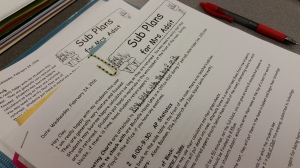My precalculus students completed a project on logs and logistics function in real world. I borrowed this activity from one of my creative and thoughtful colleagues at school. Before break, they signed up for a topic where logs or logistic functions are used. I asked them to find a topic that was interesting to them and then see if log or logistic functions play a part in the topic. They used their iPads to do a Google search on their topic.
Students signed up for two possible topics and referenced them with an online site, which they submitted through a Google Form. Since Google Forms are time stamped, I able to use a first come, first served approach to topic assignment. I allowed up to 3 people to select the same topic, but after that, they got their second choice. Out of two classes, I only had 4 students that needed to determine a new topic.

Here is a brief synopsis of what was required:
THE TASK: The end product of your webquest will be a BROCHURE describing what you have learned about your chosen application of logarithms. • Brochure style (tri-folded) • Typed in your own words • Description and history of the application (e.g. “what is a decibel?” and “who invented the Richter scale?”) • Description of mathematics used in calculations – specifically logarithms with an example • Description of at least one career in which this application is used • At least one relevant graphic Citation of other websites used beyond the ones given (just list the url)
Students submitted both a physical copy and an electronic one. I created groups of brochures with different topics and none created by a particular group member.
Today they did the peer review of the brochures, again using a Google Form. I used radial buttons for the rubric part of the assessment. There was also a required comment section. I asked students to give both a positive comment about an intellectual aspect of the topic presentation and a constructive criticism. Part of their grade is their review of their peers and their peers’ review of their pamphlet. You could have heard a pin drop.


We had 10 minutes left in class, so I tried something on the fly…never know how that will go. I asked the groups to discuss and determine the most interesting brochure. They then passed that one on to the next group. I know this will be part of the whole process next year.


















